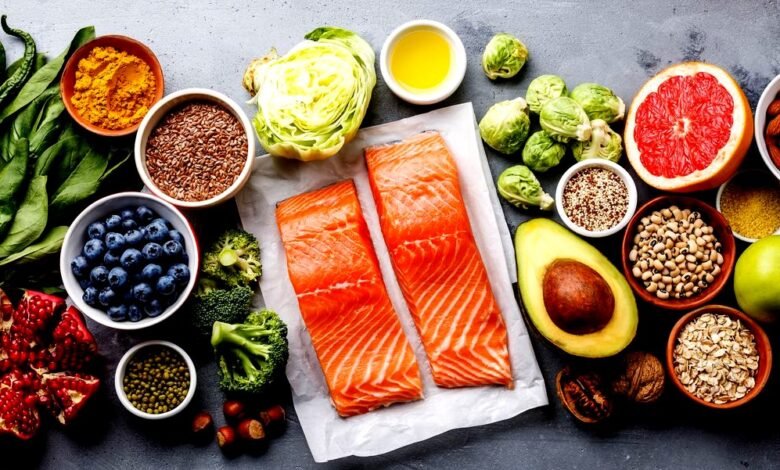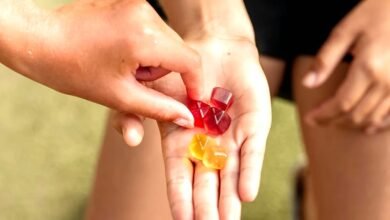Pescatarian Diet: A Complete Guide in 2024

The pescatarian diet, a unique approach to eating that combines elements of both vegetarian and pescetarian lifestyles, has been gaining popularity in recent years. This dietary choice involves the consumption of fish and seafood along with a predominantly plant-based diet. Let’s dive into the details of this fascinating and health-conscious way of eating.
EXPLORE THE CONTENTS
Benefits of the Pescatarian Diet
Rich in Omega-3 Fatty Acids
One of the standout advantages of the pescatarian diet is its abundance of omega-3 fatty acids. These essential fats play a crucial role in heart health, brain function, and inflammation reduction.
High-Quality Protein Sources
Fish and seafood are excellent sources of high-quality protein, essential for muscle development and overall body maintenance. The pescatarian diet provides a variety of protein options for individuals seeking a diverse and nutritious eating plan.
Potential Weight Management Benefits
Studies suggest that the pescatarian diet may contribute to weight management. With a focus on lean proteins and plant-based foods, individuals often find it easier to maintain a healthy weight compared to other dietary choices.
Key Components of the Pescatarian Diet
Fish and Seafood Options
Salmon, tuna, shrimp, and other seafood delicacies form the foundation of the pescatarian diet. These options bring a unique blend of flavors and nutrients to the table.
Plant-Based Foods
Embracing fruits, vegetables, whole grains, and legumes ensures a well-rounded and nutritionally sound approach. The diet encourages the consumption of a colorful array of plant-based foods.
Limited Meat Consumption
While fish and seafood are staples, the pescatarian diet minimizes or excludes other forms of meat, such as poultry and red meat. This reduction in meat consumption aligns with the diet’s focus on sustainability and health.
Nutritional Considerations
Importance of Variety
Maintaining a diverse range of food choices is vital for obtaining all necessary nutrients. Pescatarians should aim for a colorful plate to ensure they receive a spectrum of vitamins and minerals.
Potential Nutrient Deficiencies and How to Address Them
Careful planning is necessary to avoid nutrient deficiencies. Supplements or specific food choices, such as vitamin B12 or iron, can help address potential shortfalls.
Read More: 5 Amazing Health Benefits of Butternut Squash
Meal Planning Tips
Meal planning is a crucial aspect of successfully adopting the pescatarian diet. Here are comprehensive tips to help you create balanced and delicious meals:
1. Diversify Your Protein Sources:
- Explore a variety of fish and seafood options to ensure a broad spectrum of nutrients.
- Incorporate plant-based proteins like tofu, beans, and quinoa for added diversity.
2. Balance Macronutrients:
- Ensure a well-rounded meal by combining fish proteins with complex carbohydrates from whole grains and healthy fats.
- This balance promotes satiety and sustained energy levels.
3. Embrace colorful vegetables:
- Include a vibrant array of vegetables to provide essential vitamins, minerals, and antioxidants.
- Aim for a diverse range of colors to maximize nutritional benefits.
4. Plan for Omega-3-rich foods:
- Prioritize fish high in Omega-3 fatty acids, such as salmon and mackerel, to support heart and brain health.
- Supplement with flaxseeds, chia seeds, or walnuts for plant-based omega-3s.
5. Batch Cooking for Convenience:
- Prepare larger quantities of meals in advance to save time during busy days.
- Freeze portions for quick, convenient, and healthy meals on demand.
6. Experiment with Flavors:
- Spice up your meals with herbs, spices, and citrus to enhance taste without relying on heavy sauces.
- Experimenting with flavors keeps your palate engaged and prevents monotony.
7. Include whole grains:
- Choose whole grains like brown rice, quinoa, and barley to add fiber and sustained energy to your diet.
- These grains contribute to overall digestive health.
8. Mindful Portion Control:
- Be conscious of portion sizes to avoid overeating.
- Use smaller plates to create the illusion of a fuller plate while controlling portions.
9. Hydrate wisely.
- Stay hydrated with water, herbal teas, and infused waters.
- Limit sugary beverages and alcohol to maintain overall health.
10. Consult a nutritionist:
- Seek guidance from a nutrition professional to tailor your meal plans to your specific nutritional needs.
- A nutritionist can help address any potential nutrient gaps and ensure optimal health.
11. Seasonal and Local Ingredients:
- Choose seasonal and locally sourced produce for freshness and to support local farmers.
- Seasonal ingredients often offer peak flavor and nutritional value.
12. Plan for Special Occasions:
- Anticipate social events and plan pescatarian-friendly options.
- Communicate dietary preferences to hosts when attending gatherings.
13. Explore Pescatarian Cookbooks:
- Invest in cookbooks focused on pescatarian recipes for inspiration and new culinary ideas.
- These resources can introduce you to innovative ways of preparing seafood and plant-based dishes.
14. Stay Flexible and Enjoy the Process:
- Embrace flexibility in your meal plans to accommodate changing tastes and preferences.
- Enjoy the journey of discovering new foods and recipes that align with the Pescatarian lifestyle.
15. Track Your Nutrient Intake:
- Use nutrition-tracking apps to monitor your daily intake of essential nutrients.
- This ensures you meet your nutritional goals and maintain a well-balanced diet.
By incorporating these meal planning tips into your Pescatarian journey, you’ll not only enjoy a diverse and flavorful diet but also promote optimal health and well-being.
Environmental Impact
Sustainable Fishing Practices
The pescatarian diet encourages awareness of sustainable fishing practices. Choosing seafood that is responsibly sourced supports environmental conservation efforts.
Eco-Friendly Choices for Conscious Consumers
Selecting locally sourced and eco-friendly produce aligns with the Pescatarian Diet’s commitment to reducing the environmental impact of food choices.
Addressing Common Misconceptions
Clarifying Concerns About Mercury in Fish
One common misconception revolves around mercury levels in fish. The guide will clarify which fish types are safe for consumption and how to moderate intake.
Debunking Myths Related to the Diet
Dispelling myths about the pescatarian diet, such as concerns about protein adequacy and nutritional balance, helps individuals make informed choices.
Getting Started with the Pescatarian Diet
Gradual Transition Tips
For those interested in adopting the pescatarian diet, gradual transitions can make the process smoother. Tips for easing into this lifestyle will be provided.
Consultation with a Healthcare Professional
Before making any significant dietary changes, consulting with a healthcare professional ensures that the pescatarian diet aligns with individual health needs.
Success Stories
Real-Life Experiences and Transformations
Personal narratives of individuals who have successfully embraced the pescatarian diet will inspire and motivate those considering this lifestyle change.
Tips for Dining Out
Navigating Restaurant Menus
Eating out doesn’t have to be challenging. Practical tips for navigating restaurant menus and making pescatarian-friendly choices will be shared.
Making Informed Choices While Eating Out
Empowering individuals to make informed choices when dining out ensures that the pescatarian diet remains enjoyable and sustainable.
Challenges and How to Overcome Them
Dealing with Social Situations
Navigating social gatherings where non-pescatarian options are prevalent can be challenging. Strategies for handling such situations will be discussed.
Coping with Cravings for Non-Pescatarian Foods
Cravings for familiar meat-based dishes may arise. Strategies for managing and satisfying these cravings without deviating from the diet will be explored.
Fitness and the Pescatarian Lifestyle
Maintaining an Active Lifestyle
Combining the pescatarian diet with regular exercise enhances overall well-being. Tips for maintaining an active lifestyle within the context of this diet will be covered.
Combining Exercise with the Diet for Optimal Results
Understanding the synergy between physical activity and the pescatarian diet contributes to a holistic approach to health.
Recipes for a Balanced Pescatarian Diet
Delicious and Easy-to-Make Dishes
A collection of mouthwatering recipes that exemplify the diversity and flavor potential of the pescatarian diet will be shared.
Common Pitfalls to Avoid
Overconsumption of Certain Fish Species
Awareness of potential pitfalls, such as overconsumption of certain fish species, helps individuals make informed choices for their health and the environment.
Relying Too Heavily on Processed Foods
Maintaining balance and choosing whole, unprocessed foods over heavily processed alternatives is crucial for reaping the full benefits of the pescatarian diet.
Conclusion
In conclusion, the pescatarian diet offers a unique and health-conscious approach to eating. By combining the best of both the plant-based and seafood worlds, individuals can enjoy a diverse range of flavors while reaping numerous health benefits. Whether you’re considering this diet for ethical, environmental, or health reasons, the pescatarian lifestyle is worth exploring.
FAQs
- Is the pescatarian diet suitable for all age groups?
- Yes, with proper planning, the pescatarian diet can be adapted for individuals of all ages.
- What are some alternatives for individuals who are allergic to seafood?
- Plant-based protein sources like tofu, legumes, and nuts can be excellent alternatives.
- How often should one consume fish on the pescatarian diet?
- It’s recommended to include fish in your diet 2-3 times a week for optimal health benefits.
- Can the pescatarian diet be customized for specific dietary requirements?
- Absolutely, the diet is flexible and can be adjusted to accommodate various dietary needs.
- Are there any potential downsides to the pescatarian diet?
- While generally considered healthy, individuals should be mindful of mercury levels in certain fish and ensure a well-balanced diet.






